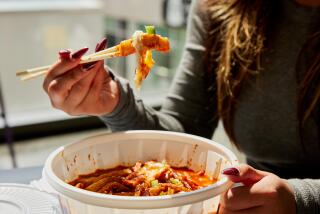Koreatown luxury high-rise is sold for $283 million
In one of the largest transactions of its type in the state this year, a luxurious new high-rise apartment and retail complex in Koreatown has sold for $283 million.
The sale is a sign of Koreatown’s rising status with young Angelenos and the desirability of housing near major transit lines. The complex, dubbed the Vermont, is at the intersection of Wilshire Boulevard and Vermont Avenue next to a subway station.
The neighborhood — anchored by the landmark former Bullocks Wilshire department store — was once one of the city’s best but fell out of favor in the 1980s and was hit hard by the 1992 riots. The area still has pockets of blight but is also now home to new housing, hotels, restaurants and stores.
“We think this is one of the iconic projects in Koreatown,” said Ken Lombard, vice chairman of investments at Chicago-based Capri Capital Partners, which bought the property with Los Angeles investment firm TruAmerica Multifamily. “It’s a very special asset in the community.”
The Vermont is one of the largest residential projects to be built in Los Angeles since the beginning of the last real estate downturn, local builder J.H. Snyder Co. said. It has 464 apartments in two towers — one 29 stories tall and the other 23.
The towers stand atop a seven-story complex containing stores, restaurants and parking. The property boasts a level of opulence that would have been unthinkable in the neighborhood a decade ago, with an expansive lobby, a tricked-out gym and a 100-foot-long rooftop swimming pool in a garden setting that includes a dog run.
The Vermont also has a $1.6-million chandelier out front in the shape of a lotus blossom and 24-hour doormen, giving it the air of a high-end hotel.
“We really wanted to get a Four Seasons feel to it,” said Jerome H. Snyder, senior partner of Snyder Co. His firm spent more than $200 million building the Vermont.
Snyder’s decision to go big in a central city neighborhood caught the attention of Capri Capital Partners, which focuses on investments in ethnically diverse urban districts on the mend.
“We very much target areas that are in transition,” said Quintin E. Primo III, chairman of Capri. “Koreatown is a classic case of that.”
The neighborhood was once one of Los Angeles’ most posh, dotted with elegant apartments and single-family homes. The now-departed Ambassador Hotel hosted presidents, royalty and the Academy Awards. Large corporations such as IBM and Texaco occupied Wilshire Boulevard office towers.
But the freeway-remote neighborhood slowly fell out of favor. In the 1980s, many white-collar businesses moved to downtown or the Westside. Crime and neglect spread. As large corporations left the Wilshire corridor, Korean businesses started moving in and Koreatown expanded from its historical center along Olympic Boulevard.
Then in spring 1992 — as the neighborhood was experiencing a rush of Korean investment — the L.A. riots swept north from South L.A. and engulfed the neighborhood. The material and psychological damage was profound, and more businesses left.
The neighborhood slowly recovered, and Korean investors seeking a haven flooded the area after the Asian financial crisis of the late 1990s.
“In the 1990s and early 2000s there was a pouring of money from South Korea,” said UCLA anthropology professor Kyeyoung Park, who has extensively studied Koreatown.
Koreatown is the most densely populated neighborhood in Los Angeles, with a high percentage of Latino and Asian residents who were born outside of the United States. It has a high concentration of Korean businesses, including numerous bars and restaurants, but is attractive to a wide range of millennials who want to live there or just visit on nights out.
“Koreatown is emblematic of the new urbanism,” said Capri’s Primo. “Its multiculturalism is increasingly attractive to young people who enjoy things new and different.”
William Lei moved into the Vermont in June. The 38-year-old came from Washington, D.C., after getting a job as a healthcare analyst in Culver City.
Lei chose Koreatown as his new home because it reminds him of New York, where he grew up — ethnically diverse with bustling restaurants.
“The great thing is the diversity,” he said. “It’s one of the reasons I wanted to live here rather than Culver City right by my work.”
Other developers are taking part in the Koreatown comeback. The trendy high-rise Line hotel opened this year at Wilshire and Normandie Avenue, after the renovation of the nearby Hotel Normandie, built in the 1920s.
Southwestern Law School, which occupies the dramatic art deco former Bullocks building, recently completed a $20-million student housing addition.
Nearly 800 new apartments have gone up in Koreatown over the last year, and 530 more are under construction or about to break ground, said property broker Javier Rivera of JLL, the real estate firm that represented Snyder in the sale.
“Koreatown is one of the fastest-growing, transit-oriented neighborhoods in Los Angeles and proximate to all things L.A. — downtown, Hollywood and the Miracle Mile,” Rivera said.
The Vermont has rented 110 units so far, Snyder said. Many of the tenants have Korean heritage, and several are graduate students from China. Rents run from the low $2,000s per month to the high $3,000s.
“We think Koreatown is an exciting neighborhood,” Capri’s Lombard said. “We are coming in at the right time.”








